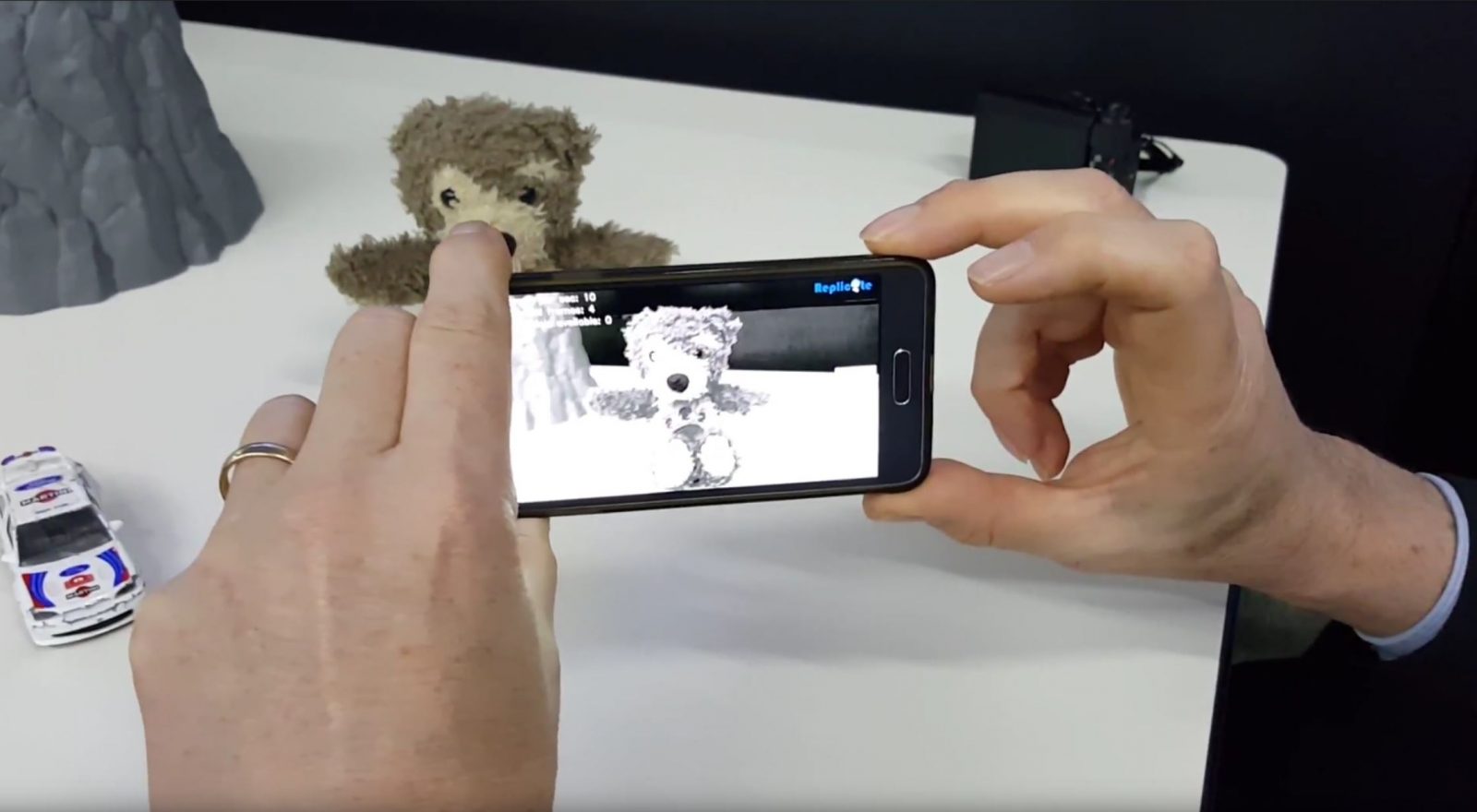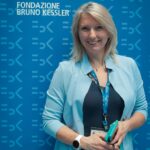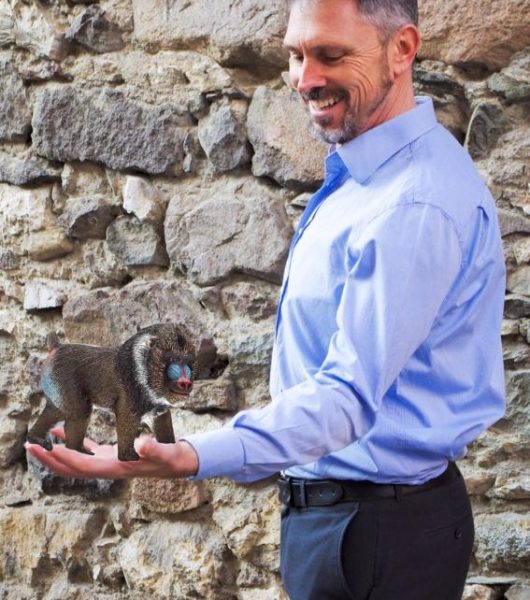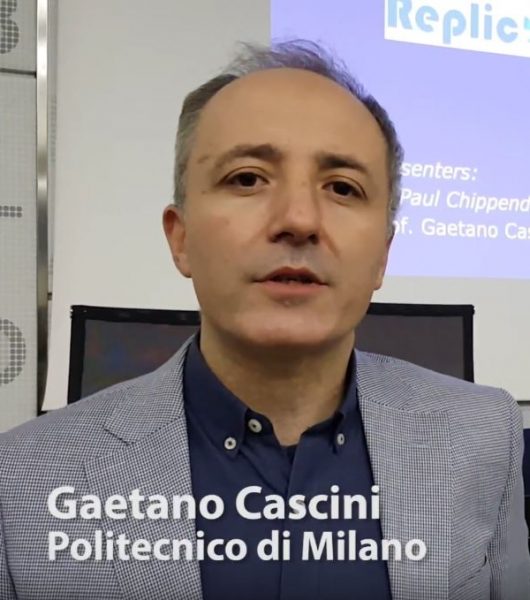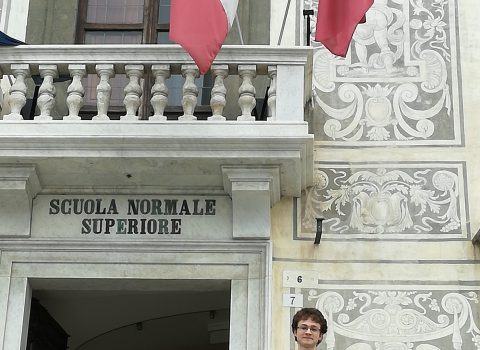Augmented reality: the “Replicate” and “Spark” projects at FBK
What if we could simply pick up our cell phones, capture the interesting stuff around us and bring take it into our future 3D virtual lives? To find out more about it, we interviewed two experts in this kind of technology: Paul Chippendale, from FBK, and Gaetano Cascini, from the Polytechnic University of Milan.
On the occasion of the day dedicated to “Augmented Reality”, which was held on March 22, 2017 at Fondazione Bruno Kessler in Trento, we discussed the topic with two managers of European projects on “Augmented Reality” (funded by the Horizon 2020 Research and Innovation program) that use machine vision technologies as a means to inspire collaboration ideas.
In particular, in the “Replicate” (Creative asset-harvesting PipeLine to Inspire Collective-Authoring and Experimentation), coordinated by FBK, the real world becomes an “amplified” reality. Leveraging smartphones and their sensors, one can create 3D reconstructions of objects and of the surrounding environment through visual and tactile user interfaces. Researchers are developing a platform that is intuitive and available at all times to make digital resources available to the “reality-derived world” in a cooperative environment where human inspiration and creativity can benefit from Augmented Reality. The motto of the project is “Creativity for everyone, anytime, anywhere.”
Thanks to augmented reality as well, the “SPARK” (SPatial Augmented Reality as a Key for co-creativity) project is used in the context of collaborative design.
Watch the video to the side!
Paul Chippendale is a senior researcher with the TeV (Technologies of Vision) Team at FBK’s ICT Center and the coordinator of the “Replicate” scientific project. Gaetano Cascini, with the Polytechnic University of Milan – Mechanics Department, coordinates the “SPARK” project.
Information sheet on the REPLICATE project: take Inspiration from the World
In REPLICATE we aim to stimulate and support collaborative creativity “Anywhere, anytime, for anyone”, this is our driving mantra. What if you could just pick up your mobile, capture the exciting things around you, and then bring them into your future 3D virtual lives?
REPLICATE’s vision is to encourage all of those digitally fanatic citizens to capture and share not only flat 2D images but more engaging 3D models. Whether you share a 3D model of your car on Facebook, or contribute to the creation of a 3D replica of your town hall, REPLICATE is working to make this possible. This passion to digitally clone parts of the real-world will also fuel the Creative Industries’ need for 3D content, seeding the next generations of video games, providing objects for Augmented Reality, and encouraging 3D printing.
High-end smartphones are nowadays powerful enough to run 3D reconstruction algorithms on-board. Also, thanks to ubiquitous internet connections, cloud computing can further push the complexity of computer vision algorithms to facilitate real-time collaborations amongst multiple creative users. In REPLICATE we maximise the strengths from both mobile and cloud computing platforms to offer a highly immersive and unique user experience..
Partners:
1) FONDAZIONE BRUNO KESSLER – Italy – www.fbk.eu
2) FRAUNHOFER HHI – Germany – www.hhi.fraunhofer.de
3) ETH – Zurich Switzerland – www.vision.ee.ethz.ch
4) GAMEWARE EUROPE – UK – www.gamewareeurope.com
5) WIKITUDE – Austria – www.wikitude.com
6) ANIMAL VEGETABLE MINERAL – UK – www.animalvegetablemineral.tv
7) T2I TRASFERIMENTO TECNOLOGICO E INNOVAZIONE – Italy – www.t2i.it
Fact sheet on the “SPARK” project: projected augmented reality in the service of design (by Polytechnic University of Milan – March 2017)
The Polytechnic of Milan is the leader of the SPARK (Spatial Augmented Reality as a Key for co-creativity) project, funded by the Horizon 2020 EU Research and Innovation program. The 36-month project aims to create a responsive and intuitive ICT platform which leverages the potential of projected augmented reality (Spatial Augmented Reality – SAR) to allow designers and engineers to share with customers and users final solutions in the form prototypes during creative brainstorming sessions. Augmented reality allows users to view the projected virtual objects on a physical prototype. Today, it is used in the process of project review. Unlike other platforms, SPARK revolutionizes the product design process, involving all stakeholders right from the start. It will enable designers and customers to modify and evaluate together and in real-time creative solutions of a product concept, getting direct feedback in a collaborative design environment. This will improve communication between designers and clients, we will limit the inefficiencies related to lack of synchronism between the design and evaluation phases, will increase the efficiency of all the creative design process.
In particular, SPARK aims to reach the following goals:
•Cutback on the time necessary for the development of a new product concept: -40% compared to today;
•Cutback on the number of worked hours for each product concept: -25%;
•Amount of approved concepts: +70%
•Cutback on costs and waste for prototype production
The effectiveness of the platform will be demonstrated through tests with control groups in design contexts as well as in real situations, within which designers from creative companies will be involved, with case studies from their daily practice.
Partners:
The multidisciplinary team includes three universities: the Polytechnic University of Milan as lead partner, the University of Bath and the Grenoble Institute of Technology, a software solutions company called Viseo, and 3 end users: ArteficeGroup, Antwerp Management School and Stimulo.
**********************************************
Interviews taken by M. Lucianer (FBK Press Office)
c/ FBK – March 2017
